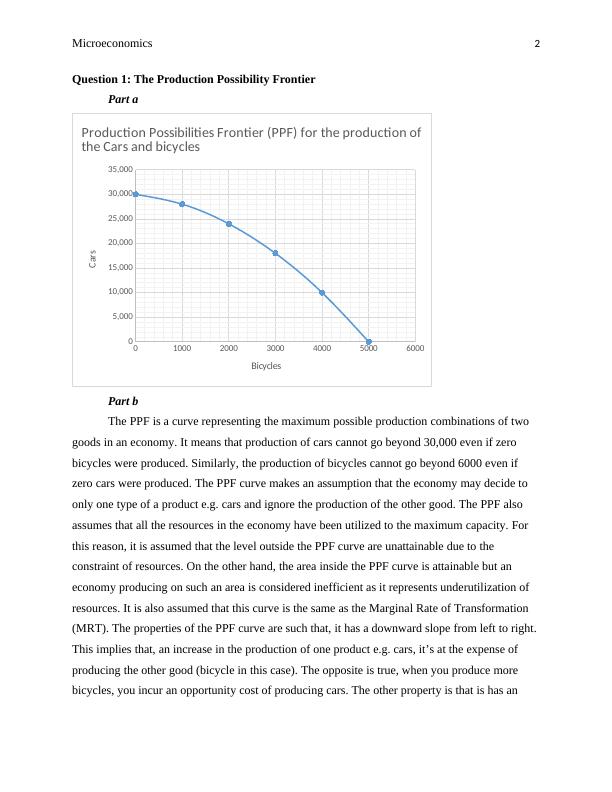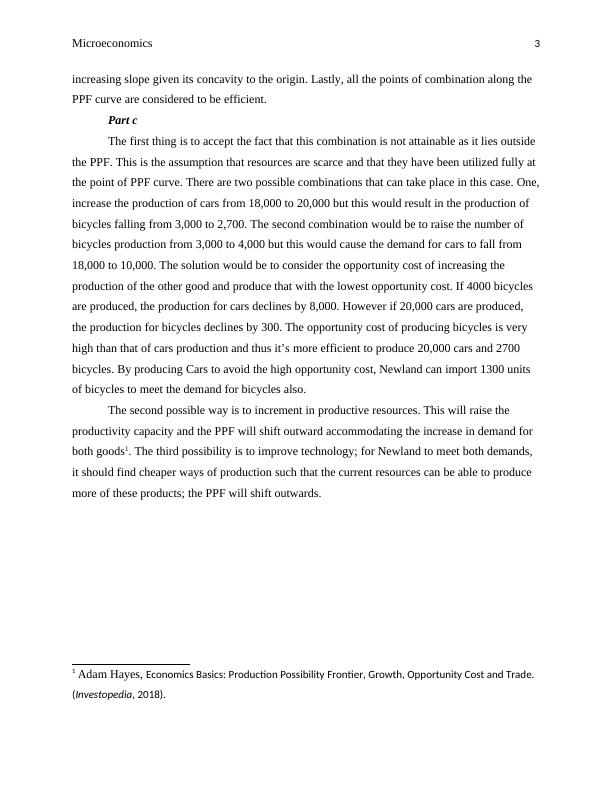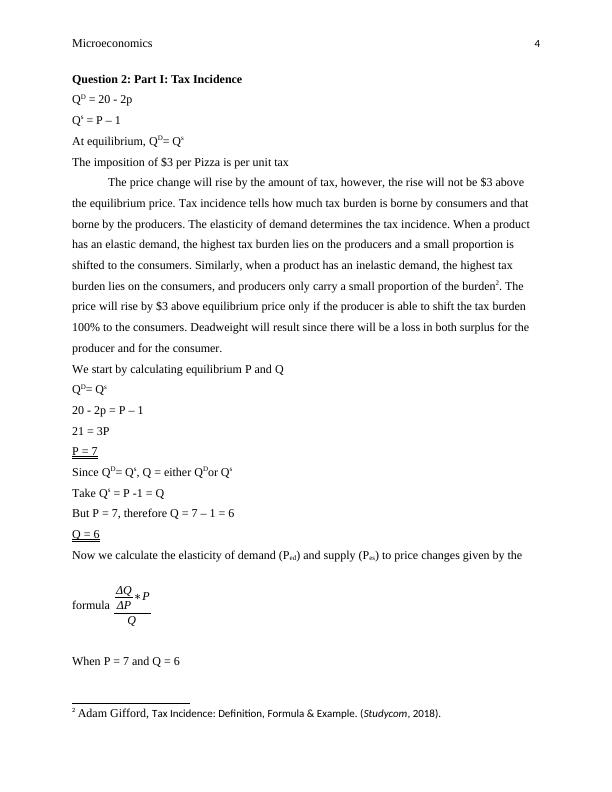Microeconomic Analysis - Doc
12 Pages1939 Words118 Views
Added on 2021-05-31
Microeconomic Analysis - Doc
Added on 2021-05-31
ShareRelated Documents
Running Head: MicroeconomicsMicroeconomic AnalysisBy (Name)Student ID(Tutor)(University)(Date)

Microeconomics2Question 1: The Production Possibility Frontier Part a010002000300040005000600005,00010,00015,00020,00025,00030,00035,000Production Possibilities Frontier (PPF) for the production of the Cars and bicyclesBicyclesCarsPart bThe PPF is a curve representing the maximum possible production combinations of two goods in an economy. It means that production of cars cannot go beyond 30,000 even if zero bicycles were produced. Similarly, the production of bicycles cannot go beyond 6000 even if zero cars were produced. The PPF curve makes an assumption that the economy may decide to only one type of a product e.g. cars and ignore the production of the other good. The PPF also assumes that all the resources in the economy have been utilized to the maximum capacity. For this reason, it is assumed that the level outside the PPF curve are unattainable due to the constraint of resources. On the other hand, the area inside the PPF curve is attainable but an economy producing on such an area is considered inefficient as it represents underutilization of resources. It is also assumed that this curve is the same as the Marginal Rate of Transformation (MRT). The properties of the PPF curve are such that, it has a downward slope from left to right. This implies that, an increase in the production of one product e.g. cars, it’s at the expense of producing the other good (bicycle in this case). The opposite is true, when you produce more bicycles, you incur an opportunity cost of producing cars. The other property is that is has an

Microeconomics3increasing slope given its concavity to the origin. Lastly, all the points of combination along the PPF curve are considered to be efficient.Part cThe first thing is to accept the fact that this combination is not attainable as it lies outside the PPF. This is the assumption that resources are scarce and that they have been utilized fully at the point of PPF curve. There are two possible combinations that can take place in this case. One,increase the production of cars from 18,000 to 20,000 but this would result in the production of bicycles falling from 3,000 to 2,700. The second combination would be to raise the number of bicycles production from 3,000 to 4,000 but this would cause the demand for cars to fall from 18,000 to 10,000. The solution would be to consider the opportunity cost of increasing the production of the other good and produce that with the lowest opportunity cost. If 4000 bicycles are produced, the production for cars declines by 8,000. However if 20,000 cars are produced, the production for bicycles declines by 300. The opportunity cost of producing bicycles is very high than that of cars production and thus it’s more efficient to produce 20,000 cars and 2700 bicycles. By producing Cars to avoid the high opportunity cost, Newland can import 1300 units of bicycles to meet the demand for bicycles also.The second possible way is to increment in productive resources. This will raise the productivity capacity and the PPF will shift outward accommodating the increase in demand for both goods1. The third possibility is to improve technology; for Newland to meet both demands, it should find cheaper ways of production such that the current resources can be able to produce more of these products; the PPF will shift outwards. 1Adam Hayes, Economics Basics: Production Possibility Frontier, Growth, Opportunity Cost and Trade. (Investopedia, 2018).

Microeconomics4Question 2: Part I: Tax Incidence QD = 20 - 2pQs = P – 1At equilibrium, QD= QsThe imposition of $3 per Pizza is per unit taxThe price change will rise by the amount of tax, however, the rise will not be $3 above the equilibrium price. Tax incidence tells how much tax burden is borne by consumers and that borne by the producers. The elasticity of demand determines the tax incidence. When a product has an elastic demand, the highest tax burden lies on the producers and a small proportion is shifted to the consumers. Similarly, when a product has an inelastic demand, the highest tax burden lies on the consumers, and producers only carry a small proportion of the burden2. The price will rise by $3 above equilibrium price only if the producer is able to shift the tax burden 100% to the consumers. Deadweight will result since there will be a loss in both surplus for the producer and for the consumer.We start by calculating equilibrium P and QQD= Qs20 - 2p = P – 121 = 3PP = 7Since QD= Qs, Q = either QDor QsTake Qs = P -1 = QBut P = 7, therefore Q = 7 – 1 = 6Q = 6Now we calculate the elasticity of demand (Ped) and supply (Pes) to price changes given by the formula ΔQΔP∗PQWhen P = 7 and Q = 62Adam Gifford, Tax Incidence: Definition, Formula & Example. (Studycom, 2018).

End of preview
Want to access all the pages? Upload your documents or become a member.
Related Documents
Introduction to Economicslg...
|14
|1837
|431
Document on Microeconomics- PPFlg...
|13
|1998
|149
Introduction To Microeconomicslg...
|14
|2312
|245
Economicslg...
|13
|1421
|438
Assignment on microeconomics PDFlg...
|19
|1964
|77
Online Library for Study Material | Deskliblg...
|13
|1439
|249
